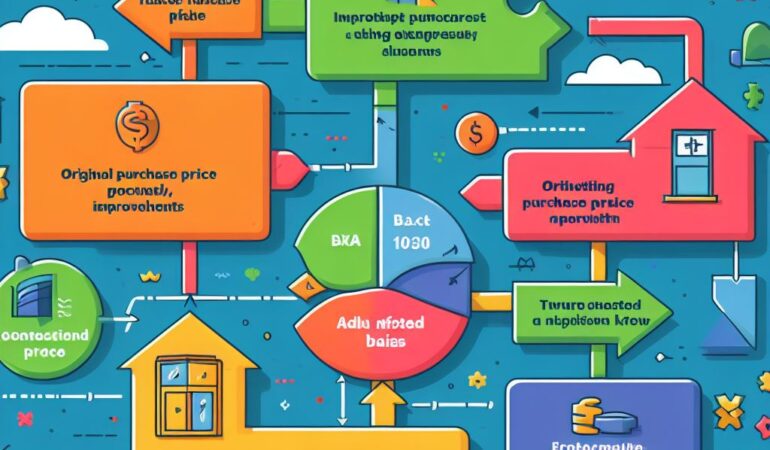Are you ready to dive into the world of 1031 exchanges? Brace yourself, because we’re about to unlock the key points to understanding tax basis.
In this article, we’ll guide you through the importance of tax basis, how to determine it for your exchanged property, and the adjustments you need to make.
We’ll also explore how tax basis ties into depreciation and calculating taxable gain or loss.
Get ready to navigate the complexities of the 1031 exchange with confidence.
Key Takeaways
- Tax basis refers to the original value of an asset for tax purposes.
- Preserving the tax basis allows for deferring capital gains tax on the sale of the property.
- Higher tax basis can result in higher depreciation deductions, reducing taxable income.
- Accurate calculation of tax basis is essential for compliance with 1031 exchange rules.
Importance of Tax Basis in 1031 Exchange
Understanding the importance of tax basis in a 1031 exchange will allow you to accurately assess the potential tax implications of your transaction. Tax basis refers to the original value of an asset for tax purposes. In a 1031 exchange, the tax basis of the relinquished property is carried over to the replacement property. This is crucial because it determines the amount of gain or loss that will be recognized for tax purposes.
By preserving the tax basis in a 1031 exchange, you can defer paying capital gains tax on the sale of your property. This allows you to reinvest the full amount of the proceeds into a new property, ultimately maximizing your investment potential. Moreover, a higher tax basis can also result in higher depreciation deductions, which can further reduce your taxable income.
To accurately calculate the tax basis, it’s important to consider factors such as the purchase price, improvements made to the property, and any depreciation claimed. Additionally, it’s essential to consult with a qualified tax professional to ensure compliance with IRS regulations and to fully understand the specific implications for your situation.
Determining Tax Basis for Exchanged Property
To determine the tax basis for the exchanged property, you will need to consider various factors such as the original purchase price, any improvements made, and depreciation claimed. The tax basis is the value used to determine the gain or loss when the property is sold or exchanged. It is essential to accurately calculate the tax basis to ensure compliance with the rules of a 1031 exchange.
To help you understand the factors involved in determining the tax basis, here is a table summarizing the key components:
| Factor | Description |
|---|---|
| Original Purchase Price | The amount you paid for the property when it was acquired. This includes the purchase price, closing costs, and any other expenses directly related to the acquisition. |
| Improvements Made | Any capital improvements or additions made to the property. This includes renovations, upgrades, and any other enhancements that increase the property’s value. |
| Depreciation Claimed | The amount of depreciation expense that has been deducted over the years. This is determined based on the property’s useful life and depreciation method used. |
Adjustments to Tax Basis in 1031 Exchange
When engaging in a 1031 exchange, there are several adjustments that can be made to the tax basis of the exchanged property. These adjustments are crucial for accurately calculating the taxable gain or loss on the property. Here are four key adjustments to consider:
- Capital Improvements: Any capital improvements made to the replacement property can be added to the tax basis. This includes renovations, additions, or any other improvements that enhance the property’s value.
- Depreciation: If you have claimed depreciation deductions on the relinquished property, the accumulated depreciation must be subtracted from the tax basis of the replacement property. This ensures that the depreciation deduction is properly accounted for.
- Assumed Liabilities: If you assume any liabilities or mortgages as part of the exchange, the amount of the liabilities assumed will be added to the tax basis. This adjustment reflects the increased financial obligations associated with the replacement property.
- Boot: If you receive any cash or other non-like-kind property (boot) as part of the exchange, the fair market value of the boot will be added to the tax basis. This adjustment accounts for the additional value received outside of the like-kind exchange.
Tax Basis and Depreciation in 1031 Exchange
When engaging in a 1031 exchange, it is important to consider the impact of depreciation on the tax basis of the exchanged property. Depreciation is an accounting method used to allocate the cost of an asset over its useful life. In the context of a 1031 exchange, the depreciation taken on the relinquished property will affect the tax basis of the replacement property.
To better understand the impact of depreciation on tax basis, let’s take a look at the following table:
| Property | Original Cost | Accumulated Depreciation | Tax Basis |
|---|---|---|---|
| Relinquished Property | $500,000 | $100,000 | $400,000 |
| Replacement Property | $600,000 | $0 | $600,000 |
In this example, the relinquished property has an original cost of $500,000 and an accumulated depreciation of $100,000. As a result, the tax basis of the relinquished property is reduced to $400,000. On the other hand, the replacement property has no accumulated depreciation, so its tax basis remains at $600,000.
When completing a 1031 exchange, the tax basis of the replacement property is determined by subtracting any accumulated depreciation on the relinquished property from its original cost. It is crucial to consider this tax basis adjustment to accurately calculate future depreciation and potential capital gains taxes.
Calculating Taxable Gain or Loss in 1031 Exchange
You need to calculate the taxable gain or loss in your 1031 exchange. This calculation is important in determining the amount of taxes you may owe as a result of the exchange. Here are the steps you should follow to calculate the taxable gain or loss:
- Determine the adjusted basis of the relinquished property: Start with the original purchase price and add any capital improvements made over the years. Then, subtract any depreciation claimed during the ownership period.
- Subtract the adjusted basis from the sale price of the relinquished property: This will give you the realized gain or loss from the sale.
- Subtract any transaction costs: Deduct any expenses incurred during the exchange, such as brokerage fees or legal fees.
- Apply any allowable exclusions or deferrals: Certain types of property, such as personal residences or properties used for business purposes, may qualify for exclusions or deferrals, reducing or delaying the taxable gain.
By following these steps, you’ll be able to accurately calculate the taxable gain or loss in your 1031 exchange.
It’s recommended to consult with a tax professional or 1031 exchange specialist to ensure compliance with tax laws and regulations.
Frequently Asked Questions
What Are the Potential Tax Consequences if the Tax Basis Is Not Properly Determined for the Exchanged Property in a 1031 Exchange?
If the tax basis is not properly determined for the exchanged property in a 1031 exchange, you could face potential tax consequences. These consequences may include unexpected tax liabilities and potential penalties from the IRS.
Can the Tax Basis of the Replacement Property Be Higher Than the Tax Basis of the Relinquished Property in a 1031 Exchange?
Yes, the tax basis of the replacement property can be higher than the tax basis of the relinquished property in a 1031 exchange. This can result in additional depreciation deductions and potential tax savings.
How Does the Length of Time the Property Was Held Impact the Tax Basis in a 1031 Exchange?
The length of time you hold the property in a 1031 exchange can impact the tax basis. The longer you hold the property, the more potential for appreciation in value, which can affect your tax liability.
Are There Any Specific Rules or Limitations Regarding Depreciation Adjustments to Tax Basis in a 1031 Exchange?
There are specific rules and limitations regarding depreciation adjustments to tax basis in a 1031 exchange. These rules can affect the amount of depreciation that can be carried over to the replacement property.
Can the Tax Basis of the Replacement Property Be Adjusted After the Completion of the 1031 Exchange?
Yes, you can adjust the tax basis of the replacement property after completing a 1031 exchange. This allows you to increase your depreciation deductions and potentially reduce your taxable income.




